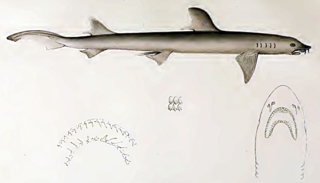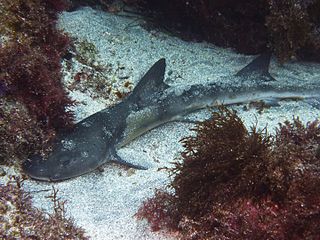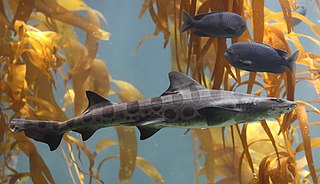
Carcharhiniformes, the ground sharks, with over 270 species, are the largest order of sharks. They include a number of common types, such as catsharks, swellsharks, and the sandbar shark.

The barbeled houndshark is a species of ground shark and the only member of the family Leptochariidae. This demersal species is found in the coastal waters of the eastern Atlantic Ocean from Mauritania to Angola, at depths of 10–75 m (33–246 ft). It favors muddy habitats, particularly around river mouths. The barbeled houndshark is characterized by a very slender body, nasal barbels, long furrows at the corners of the mouth, and sexually dimorphic teeth. Its maximum known length is 82 cm (32 in).

The sicklefin weasel shark is an uncommon species of ground shark in the family Hemigaleidae. It is native to southern India, southern China, and parts of Southeast Asia, living in shallow waters down to a depth of 170 m (560 ft). This lightly built shark is characterized by its very short mouth, broad upper teeth with serrations only on the trailing edge, and strongly sickle-shaped fins with obvious white tips on the two dorsal fins. It is light grey or bronze in colour, often with small white blotches on its sides; it reaches a maximum known length of 1.1 m (3.6 ft).

The whiskery shark is a species of houndshark in the family Triakidae, and the only member of its genus. This common shark inhabits the Australian continental shelf from Western Australia to the Bass Strait, to a depth of 220 m (720 ft). It is demersal in habits and prefers rocky and vegetated habitats. Stout-bodied and almost "humpbacked" in form, the whiskery shark can be distinguished from all other members of its family by the presence of long nasal barbels. Its two moderately large dorsal fins are roughly equal in size. It is brownish gray above and lighter below, with a pattern of darker saddles and blotches in younger sharks. This species reaches 1.6 m (5.2 ft) in length.

The blacktip tope, also known as pencil shark or blacktip topeshark, is a houndshark of the family Triakidae, and the only member of the genus Hypogaleus. It is found in the deep waters of the continental shelf in the Indo-West Pacific, from East Africa to Japan, at depths between 40 and 230 m. It can grow up to a length of 1.27 m.

The flapnose houndshark is a houndshark of the family Triakidae, and the only member of the genus Scylliogaleus. It is found in the waters off subtropical South Africa, in the western Indian Ocean between latitudes 27 and 33°S.

The sharpfin houndshark is a houndshark of the family Triakidae. Only two specimens have been found, both in the coastal waters of Ecuador, the longest one being 1.02 m in length. The reproduction of this houndshark is ovoviviparous.

The sharptooth houndshark, or spotted gully shark is a species of houndshark in the family Triakidae found in shallow inshore waters from southern Angola to South Africa. Favoring sandy areas near rocky reefs and gullies, it is an active-swimming species that usually stays close to the bottom. This robust shark reaches 1.7 m (5.6 ft) in length and has characteristically large, rounded fins; the pectoral fins in particular are broad and sickle-shaped in adults. It also has a short, blunt snout and long furrows around its mouth. This species is gray or bronze in color above, with variable amounts of black spotting.

The banded houndshark is a species of houndshark in the family Triakidae, common in the northwestern Pacific Ocean from the southern Russian Far East to Taiwan. Found on or near the bottom, it favors shallow coastal habitats with sandy or vegetated bottoms, and also enters brackish water. This shark reaches 1.5 m (4.9 ft) in length. It has a short, rounded snout and mostly narrow fins; the pectoral fins are broad and triangular, and the trailing margin of the first dorsal fin is almost vertical. It is gray above and lighter below; younger sharks have darker saddles and dots, which fade with age.

The sicklefin houndshark is a rare houndshark of the family Triakidae, endemic to Western Australia. The holotype was collected from a depth of 150 m. Its reproduction is ovoviviparous.

The Japanese topeshark is a species of houndshark, in the family Triakidae. It can reach a length of up to 1.1 m. It is found in the subtropical northwest Pacific from China, Taiwan, Korea, and Japan, between latitudes 40° N and 21° N.

The whitefin topeshark is a houndshark of the family Triakidae, found only in the tropical waters of the Philippines between latitudes 20° N and 5° N. They inhabit the coastal areas. They can grow up to a length of 96 cm. Adolescent specimens have dark areas on their caudal fins. The reproduction of this shark is ovoviviparous.

The sicklefin smooth-hound is a houndshark of the family Triakidae. Even some species look similar to Carcharhinus family, mustelus second dorsal fin is much bigger. It is found on the continental shelves of the eastern Pacific, between latitudes 33° N and 7° N. The difference between sharptooth smooth-hound and mustelus lunulatus, is that the lunulatus second dorsal fin origin far in advance of the anal fin. It can reach a length of up to 1.7 m. The reproduction of this shark is ovoviviparous.
This genus is characterized by a rounded snout and short gill slits. The mouth is short and broadly arched; the teeth have very short cusps, without toothless spaces at the jaw midlines. The dorsal and pelvic fins, and the lower caudal lobe are strongly falchate. At one time or another, this genus has encompassed up to nine species, but most were eventually split off into other genera. Neogaleus Whitley, 1931 is a junior synonym of this genus.
The Indonesian houndshark is a species of houndshark in the genus Hemitriakis. It is a tropical houndshark, known from the eastern Indonesian islands of Bali and Lombok, in the Indian Ocean. It was described by William T. White, Leonard J.V. Compagno, and Dharmadi in 2009. Females give birth to live young, with no placenta or yolk sac, and can have between six and 11 pups in one litter. When born, the pups measure 28-30 cm long. At first maturity, the houndsharks measure 90 cm, and males can go on to reach a maximum length of 120 cm, while females can reach a maximum length of 115 cm.
















